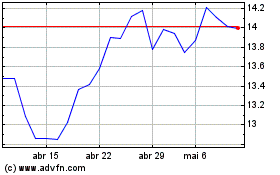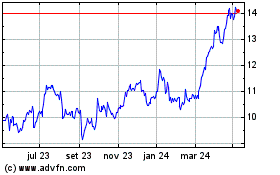By Patricia Kowsmann
Interest rates have been negative in Europe for years. But it
took the flood of savings unleashed in the pandemic for banks
finally to charge depositors in earnest.
Germany's biggest lenders, Deutsche Bank AG and Commerzbank AG,
have told new customers since last year to pay a 0.5% annual rate
to keep large sums of money with them. The banks say they can no
longer absorb the negative interest rates the European Central Bank
charges them. The more customer deposits banks have, the more they
have to park with the central bank.
That is creating an unusual incentive, where banks that usually
want deposits as an inexpensive form of financing, are essentially
telling customers to go away. Banks are even providing new online
tools to help customers take their deposits elsewhere.
Banks in Europe resisted passing negative rates on to customers
when the ECB first introduced them in 2014, fearing backlash. Some
did it only with corporate depositors, who were less likely to
complain to local politicians. The banks resorted to other ways to
pass on the costs of negative rates, charging higher fees, for
instance.
The pandemic has changed the equation. Savings rates skyrocketed
with consumers at home. And huge relief programs from the ECB have
flooded banks with excess deposits. Banks also have used the
economic dislocation of the pandemic to make operational changes
they have long resisted.
Alex Bierhaus, a managing director at a fintech company in
Düsseldorf, received a letter from his bank, a unit of Commerzbank,
last year saying it was going to start charging a 0.5% interest on
deposits above EUR100,000, equivalent to $121,000.
To avoid paying, Mr. Bierhaus, whose savings ballooned without
trips to restaurants and vacations, shifted some EUR60,000 to a
bank in Italy and one in Sweden through an online platform called
Raisin, which allows customers to shop for better rates at banks
across Europe.
Mr. Bierhaus can't even remember the name of his new banks but
said he felt comfortable given that Europe has domestic guarantees
on all deposits up to EUR100,000. He is receiving 0.8% interest on
the one-year fixed deposits, similar to a certificate of
deposit.
"I wouldn't mind receiving nothing for my deposit, but being
asked to pay is just too much," the 34-year-old said, adding that
he plans to use the money to buy a house before the birth of his
second child this year.
"Our primary objective is not to collect such a deposit, but to
advise and reallocate funds to other forms of investment," said a
Commerzbank spokesman.
According to price-comparison portal Verivox, 237 banks in
Germany currently charge negative interest rates to private
customers, up from 57 before the pandemic hit in March of last
year. Charges range between 0.4% and 0.6% for deposits beginning
anywhere from EUR25,000 to EUR100,000.
Raisin said business in Germany, its largest market, has risen
sharply as more banks have begun charging for deposits. The number
of customers using its platforms across Europe rose more than 40%
to 325,000 in 2020. The volume of deposits that moved through the
platforms rose by 50% to about EUR30 billion.
It also works with a handful of banks in Germany and elsewhere
in Europe, embedding its service inside bank websites, making it
easy for customers to shift their money.
Deutsche Bank, which charges a negative rate to new customers
holding more than EUR100,000, bought a stake in a Raisin competitor
called Deposit Solutions. Deutsche Bank clients use Deposit
Solutions to pick deposit offerings currently at five different
banks, including in Italy, Austria and France.
"Our job is to show clients ways to earn a return on their
investments despite negative interest rates," a Deutsche Bank
spokeswoman said.
The ECB's deposit rate, which it charges banks, is minus 0.5%.
The central bank has signaled it is unlikely to change that level
anytime soon. Government bond yields, against which borrowing costs
are measured, are negative despite a recent uptick. German 10-year
bunds yield minus 0.3%. Similar U.S. bonds yield 1.5%.
Banks in Germany are particularly hit by negative rates because
Germans are big savers. About 30% of all household deposits in the
eurozone are in Germany, according to the ECB. Last year, deposits
in the country rose 6% to a record EUR2.55 trillion as people
became wary of spending under the pandemic or simply had nowhere to
spend, with restaurants closed and travel restricted.
In Denmark, where interest rates were cut to below zero two
years before the eurozone, banks have gone from charging wealthier
clients to smaller ones over the past year. The Danish central bank
estimates about a quarter of the country's depositors are currently
being affected.
Nordea Bank Abp recently lowered the deposit threshold for a
0.75% charge to 250,000 danish krone, equivalent to $41,000, from
750,000 danish krone as the pandemic will likely prolong the era of
negative rates.
The flip side for customers there, is that in some cases, while
they pay to deposit money, they don't have to pay anything to
borrow. Nordea in January started offering 20-year mortgages at
0%.
Write to Patricia Kowsmann at patricia.kowsmann@wsj.com
(END) Dow Jones Newswires
March 01, 2021 05:44 ET (10:44 GMT)
Copyright (c) 2021 Dow Jones & Company, Inc.
Commerzbank (TG:CBK)
Gráfico Histórico do Ativo
De Mar 2024 até Abr 2024

Commerzbank (TG:CBK)
Gráfico Histórico do Ativo
De Abr 2023 até Abr 2024
